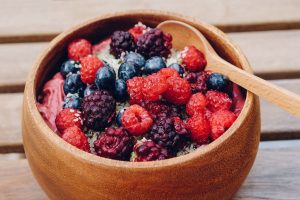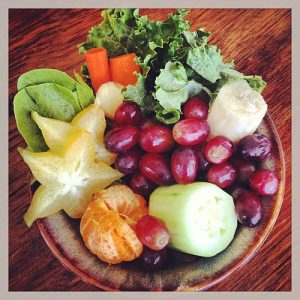Antioxidants are like the superheroes of your body. They’re tiny molecules that protect your cells from harm caused by toxins and stress like midterms, air pollution, poor sleep, and even too much exercise. How does this happen? Toxins and stress can produce free radicals, unstable molecules that wreak havoc in the body. But what are these free radicals? Think of them as little troublemakers – they’re unstable compounds that can mess things up inside your body, including your skin, cells, organs, and even your DNA!
Never fear though, antioxidants – which we consume through foods ( colorful fruits, vegetables, nuts, and beans — including coffee and chocolate) – are here to save the day! They kick out free radicals and repair the damage. Boulder: We’ve got the skinny here, so grab your coffee or berry-green smoothie and read on!
Foods That Pack a High Antioxidant Punch
- Dark Chocolate: With up to 15 mmol of antioxidants per 3.5 ounces, dark chocolate is a delightful treat that also provides zinc and iron.
- Blueberries: These small, vibrant berries contain antioxidants called anthocyanins, which may reduce disease risk and benefit heart health.
- Strawberries: Sweet and vitamin C-rich, strawberries also contain anthocyanins that support heart health.
- Spinach: This leafy green powerhouse offers vitamins, minerals, and antioxidants.
- Kale: Another cruciferous gem, kale is highly nutritious and packed with antioxidants.
- Nuts and Seeds: Almonds, walnuts, chia seeds, and flaxseeds are rich in antioxidants, healthy fats, and fiber.
- Coffee: A cup of joe provides antioxidants like chlorogenic acid, which may reduce inflammation and support overall health.
- Green Tea: Known for its catechins, green tea is a superstar antioxidant beverage that promotes well-being.
- Artichoke: Rich in chlorogenic acid, artichokes may reduce cancer risk and support heart health.
- Red Cabbage: Its vibrant color comes from anthocyanins, which also contribute to heart health and inflammation reduction.
- For More Information, check out Dr. Bray’s Blog: https://www.brennabray.com/2023/12/18/brennas-low-gi-antioxidant-smoothie/.
Remember, these antioxidant-rich foods are like your body’s own defense squad, fighting off oxidative stress and damage to your cells and DNA. Keep ’em coming!
What Can Antioxidants Do For Me?
The health benefits of anti-oxidants are truly mind-blowing — ranging from the aesthetic (glowing skin, hair, nails, anti-aging, and weight loss) and athletic (anti-inflammatory, improved metabolism, strength, bone health, performance, and recovery) to the truly awe-inspiring and medicinal (anti-aging, anti-cancer, anti-atherosclerosis, anti-inflammatory, disease preventing, delaying, and reversing).
blood sugar management, heart health, cognitive performance (e.g., focus, brain health), sports recovery, mood, and more!
- Anti-Inflammatory Aces: Berries, citrus, leafy greens, carrots, spices, nuts, and beans (coffee & cocoa too!) maximize these benefits.
- Anti-Aging: Antioxidants reduce cellular damage, slow aging, and delay degenerative diseases at the cellular & biological levels.
- Blood Sugar & Diabetes: The low GI and fiber content in most antioxidant foods help stabilize blood sugar levels and manage diabetes.
- Bone Health: Tomatoes, watermelon, dark greens, and berries boost bone health and metabolism, strength, fitness, aging, & weight in turn!
- Brain Boosting: Berries, leafy greens, nuts and seeds, coffee, green tea, and hemp or omega-3s can help attention, focus, wit, and brain power!
- Beauty: Citrus, carrots, nuts, seeds, whole grains, and avocados are great for glowing skin, hair, and nails.
- Heart Health: Citrus, berries, greens, chocolate, coffee, & tea can improve cholesterol, blood pressure, and arteries to fight heart disease.
- Immune Boosting: Load up citrus, berries, and dark leafy greens to avoid the flu, common cold, COVID-19, and even Cancer!
- Improved Liver, Lungs, & Vision: Antioxidants are great for almost all organs and organ function by reducing cell damage.
- Weight & Metabolism: By reducing inflammation, antioxidants can help reduce weight and boost metabolism.
How Do Antioxidants Work?
Environmental stressors and toxins like midterm exams, long Zoom meetings, poor sleep, air pollution, and even intense exercise can cause damage to our bodies at the cellular level. This happens because of their ability to make molecules in the body unstable, creating free radicals. Free radicals are the body’s equivalent of a toddler throwing a temper tantrum and breaking everything in sight.
Antioxidants are molecules we consume through colorful foods – berries, citrus, veggies, nuts, herbs, spices, and beans, including chocolate and coffee. Antioxidants neutralize free radicals and repair their damage. They are like the nanny who coaxes the toddler to nap time and cleans up the mess, the star quarterback who scores 2 touchdowns at the end of the game for the win, or the first-morning cup of coffee or glass of wine at the end of a hard day that makes everything OK.
The ABC’s of Antioxidants: Breaking Down the Basics
- Free Radicals: These pesky free radicals are constantly being formed in your body. They come from various sources like pollution, stress, and even intense exercise. If left unchecked, they can cause damage to your cells, DNA, and other important biological processes.
- Antioxidants to the Rescue: Enter the antioxidants! These molecules neutralize those free radicals. They’re like our beloved Boulder firefighters who show up to put out the flames. Antioxidants keep things balanced and prevent too much damage.
- Health Benefits: Antioxidants are found in plant-based foods – think colorful fruits, veggies, and berries.Vitamins E and C are superstar antioxidants. When you munch on blueberries, spinach, or even a juicy grapefruit, you’re getting a dose of these protective molecules.
- Oxidative Stress: When free radicals outnumber antioxidants [e.g. when the destroyers outnumber the help], this leads to something called oxidative stress. Imagine a seesaw that you want to stay in balance. Too much oxidative stress can damage and even alter your DNA, increase cancer risk, and even speed up aging.
So, next time you enjoy a handful of blueberries, pack a spinach juice or smoothie into your lunch, pour your morning coffee or post-work glass of wine, know that you’re giving your body a boost of antioxidants that can act as little shields defending your cells, improving your health, and maybe even saving your life!
Want to Learn More? Sources:
- Halliwell B. Understanding Mechanisms of Antioxidant Action in Health and Disease. Nature reviews Molecular cell biology (2024) 25(1):13-33. Epub 2023/09/16. doi: 10.1038/s41580-023-00645-4.
- Wang Y, Liu XJ, Chen JB, Cao JP, Li X, Sun CD. Citrus Flavonoids and Their Antioxidant Evaluation. Critical reviews in food science and nutrition (2022) 62(14):3833-54. Epub 2021/01/14. doi: 10.1080/10408398.2020.1870035.
- Ozawa H, Miyazawa T, Burdeos GC, Miyazawa T. Biological Functions of Antioxidant Dipeptides. J Nutr Sci Vitaminol (Tokyo) (2022) 68(3):162-71. Epub 2022/06/30. doi: 10.3177/jnsv.68.162.
- Fujii J, Osaki T, Bo T. Ascorbate Is a Primary Antioxidant in Mammals. Molecules (2022) 27(19). Epub 2022/10/15. doi: 10.3390/molecules27196187.
- Bjørklund G, Shanaida M, Lysiuk R, Antonyak H, Klishch I, Shanaida V, et al. Selenium: An Antioxidant with a Critical Role in Anti-Aging. Molecules (2022) 27(19). Epub 2022/10/15. doi: 10.3390/molecules27196613.
- Lu W, Shi Y, Wang R, Su D, Tang M, Liu Y, et al. Antioxidant Activity and Healthy Benefits of Natural Pigments in Fruits: A Review. International journal of molecular sciences (2021) 22(9). Epub 2021/06/03. doi: 10.3390/ijms22094945.
- Wang Y, Wu Y, Wang Y, Xu H, Mei X, Yu D, et al. Antioxidant Properties of Probiotic Bacteria. Nutrients (2017) 9(5). Epub 2017/05/24. doi: 10.3390/nu9050521.
- Huang G, Mei X, Hu J. The Antioxidant Activities of Natural Polysaccharides. Curr Drug Targets(2017) 18(11):1296-300. Epub 2017/01/25. doi: 10.2174/1389450118666170123145357.
- Baek J, Lee MG. Oxidative Stress and Antioxidant Strategies in Dermatology. Redox report : communications in free radical research (2016) 21(4):164-9. Epub 2015/05/29. doi: 10.1179/1351000215y.0000000015.








